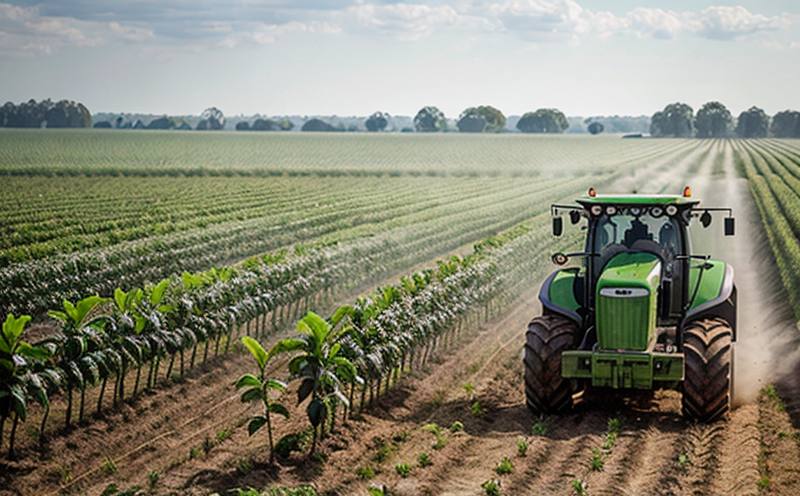EPA 8321 Organic Agricultural Chemical Testing in Soil and Water
The EPA method 8321 is a widely recognized standard for the determination of organic agricultural chemicals in soil, water, plant tissue, and manure. This method is crucial for ensuring compliance with regulatory requirements for organic agriculture, particularly under the USDA National Organic Program (NOP).
This testing procedure involves the extraction of organic compounds from various matrices using dichloromethane or ethyl acetate solvents followed by cleanup steps to remove interfering substances like salts and pesticides. The cleaned extracts are then analyzed via gas chromatography-mass spectrometry (GC-MS) for identification and quantification.
The method is designed to detect a wide range of compounds, including fungicides, herbicides, insecticides, growth regulators, and other agricultural inputs used in conventional agriculture. However, it focuses specifically on identifying residues that are not allowed under the NOP guidelines when used as organic products or processes.
Given the stringent requirements for organic certification, accurate and reliable testing is paramount to avoid non-compliance issues. This method ensures that producers can demonstrate adherence to the NOP standards, thereby protecting consumer trust in organically grown produce.
The scope of this service includes not only laboratory analysis but also consultation on best practices for sample collection, storage, and transportation to maintain integrity throughout the testing process. Our team of experts works closely with clients to ensure that all aspects of the testing are conducted according to the most current standards set forth by the EPA.
Understanding the intricacies of this method requires a deep dive into its technical components:
- The use of specific solvents tailored to each matrix type.
- Cleanup procedures aimed at eliminating interferences that could skew results.
- Instrumentation and software capable of handling complex mixtures common in agricultural samples.
By adhering strictly to these protocols, we provide accurate data necessary for making informed decisions regarding the use of agricultural chemicals within an organic framework. This approach not only aids in maintaining regulatory compliance but also enhances overall product quality assurance.
In summary, EPA 8321 is essential for those involved in organic agriculture who need reliable testing to ensure their operations meet stringent certification requirements. Our laboratory uses this method alongside other relevant standards such as NOP and international guidelines like ISO 17025 to deliver comprehensive service.
The following table summarizes the key applied standards:
| Standard | Description |
|---|---|
| EPA Method 8321 | Determination of organic agricultural chemicals in soil, water, plant tissue, and manure. |
| USDA NOP | National Organic Program regulations governing the production of organic products. |
| ISO 17025 | Accreditation criteria for testing and calibration laboratories. |
These standards form the foundation of our testing procedures, ensuring accuracy, reliability, and consistency in every analytical result produced by our laboratory.
Applied Standards
| Standard | Description |
|---|---|
| EPA Method 8321 | Determination of organic agricultural chemicals in soil, water, plant tissue, and manure. |
| USDA NOP | National Organic Program regulations governing the production of organic products. |
| ISO 17025 | Accreditation criteria for testing and calibration laboratories. |
The application of these standards ensures that our laboratory meets the highest quality assurance requirements, providing clients with confidence in their test results.
Benefits
- Achieves accurate detection and quantification of organic agricultural chemicals.
- Ensures compliance with USDA NOP regulations for organic certification.
- Reduces the risk of non-compliance penalties by providing reliable data.
- Enhances product quality assurance through rigorous testing protocols.
- Saves time and resources by offering comprehensive consulting services on sample preparation.
- Supports decision-making processes related to agricultural chemical usage within organic frameworks.
The benefits extend beyond regulatory compliance; they contribute significantly to the integrity of organically produced goods, fostering consumer trust in sustainable farming practices.
Why Choose This Test
- Comprehensive coverage of organic agricultural chemicals.
- Accurate and reliable results due to strict adherence to EPA Method 8321.
- Consultative support for sample collection, storage, and transport.
- Accreditation according to ISO 17025 standards ensuring reliability.
- Expertise in handling complex mixtures typical of agricultural samples.
Selecting this test ensures that clients are equipped with the necessary tools to maintain compliance while enhancing the overall quality and reputation of their organic products.





